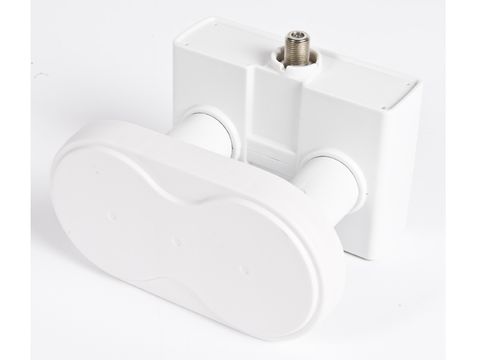TechRadar Verdict
A very handy gadget if you're looking to expand your satellite horizons on a budget
Pros
- +
Easy to install
- +
Works well
- +
Inexpensive
Cons
- -
Spacing between satellites 'fixed'
- -
Not for dishes with extended side support struts
- -
Not as flexible as DiSEqC motorised mount
Why you can trust TechRadar
A monoblock – basically, a single LNB designed to receive two satellites with one dish – is obviously not as flexible as motorisation.
Switching between satellites – it has built-in DiSEqC 1.0 switchboxes for this purpose – is, however, much faster and reliable because the dish doesn't have to move. Installation is easier too.
The Smart Titanium TMS43 has a 4.3° spacing. It's designed to meet the needs of those wanting channels on both the Hot Bird 1x cluster (13°E) and the new Eurobird 9A (9.0°E), a popular source of adult channels.
The universal LNB of the TMS43 is said to have a 0.1dB noise figure – a specification that can be taken with a pinch of salt. The unit is white (to reflect radiation and keep as cool as possible) and is supplied with a weather-resistant 'boot' for its F-socket. No wonder the TMS43 can carry a five-year guarantee.
Also included is an LNB bracket adapter. It proved simple to install the device on an off set dish of 80cm average diameter – the recommended size.
But you can't use dishes with side-mounted supporting struts for the LNB boom; these include some Channel Master and Andrews models. Such struts can foul the large body of the TMS43 and limit its adjustment range. They could, says Satellite Superstore, also cast a 'shadow', reducing the available signal.
The LNB is positioned in the bracket (the left Hot Bird feed – if looking at the rear of the LNB – is the one that's inserted) and the dish 'peaked' for Hot Bird.
Then switch over to Eurobird, rotating the assembly within the bracket slightly until best reception is achieved (use a signal meter).
The TMS43 worked surprisingly well; little further adjustment was needed for good results from the secondary satellite. DiSEqC position 2 selects Hot Bird, while DiSEqC position 1 selects Eurobird 9A.
All of the key transponders of both satellites were easily received. It's a great proposition if you want reception of these two birds at minimal cost.
Follow TechRadar Reviews on Twitter http://twitter.com/techradarreview

I'm off to France this summer, and this app could make me très fluent

Intel unveils flurry of new Arc GPUs — however serious graphics users will have to wait for more powerful models, as these focus on a completely different and more lucrative market

We just got another hint that the Samsung Galaxy Watch 7 is almost here
